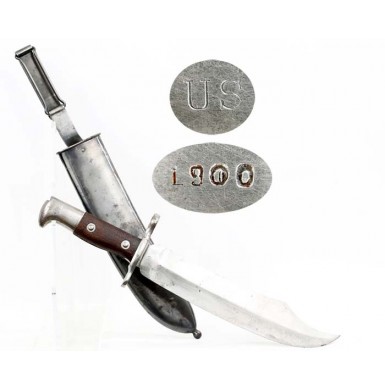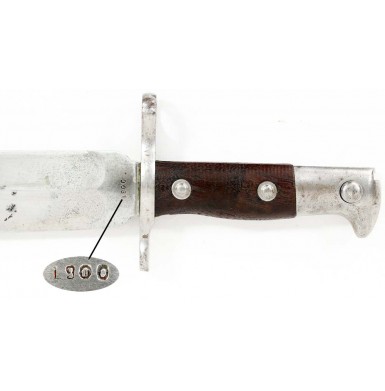This is a FINE condition example of the rarely encountered US M-1900 Bayonet & Entrenching Tool, known to collectors simply as the Krag Bowie Bayonet. According to Paul Kiesling's Bayonets of the World, a total of 2,800 of these combination bayonet / entrenching tools were produced at Springfield Armory in 1900, with 1,500 sent to the Philippines and 500 sent to Cuba for field testing. Most other sources place production at only 2,000 units. The bayonet was a continuation in of the US Ordnance Department's long-standing desire to combine multiple field implements into a single multi-use tool. The various M1873 Trapdoor "Trowel" bayonets produced in the early 1870s and the subsequent M1874 combination entrenching tool and bayonet were early attempts to accomplish this goal. While the theory was the combination of the bayonet and entrenching tool would reduce the load a soldier carried while on campaign, the more likely rational was to save money and to only procure one item instead of two. The "Krag Bowie", like the combination bayonets that preceded it, was a dismal failure in the field. It proved an awkward and cumbersome bayonet in use and a practically worthless entrenching tool. It was simply too small and too light to serve as an effective digging implement. Most of the bayonets saw more service as improvised machetes in the Philippine jungles than they did as bayonets or digging implements. This fact lead to the next major attempt to create a combination bayonet, the series of Krag Bolo Knife bayonets, which were also dismal failures.
This US Model 1900 Krag Bowie Bayonet is complete, correct and original in every way. The bayonet blade has a nice bright sheen to the blade, which appears to be a combination of the original arsenal bright polish and some later light cleaning. The ricasso is clearly marked on the obverse with a crisp US and on the reverse with the year of production, 1900. The date 1900 appears to have been over stamped, with weak, thinner numbers present under the more deeply struck numbers. I have noticed this on a couple of other examples of this pattern of bayonet and it appears the blade date was simply too weak and was subsequently re-struck with newer dies. The weaker font and the new font are not the same, but I have also seen this same type of mixed font numbering in the serial numbers of Springfield Arsenal produced M-1905 bayonets as well. The 9 1/16" long Bowie style blade is mostly smooth without any pitting but there is some lightly scattered pinpricking present, as well as some tiny patches of lightly oxidized etching. The cutting edge of the blade shows some minor scuffing as well, but the blade does not appear to have ever been sharpened. The blade also shows some scuff marks and minor surface scratches. The bayonet has an overall length of 13 5/8". The standard Krag pattern grip is in fine condition with two lovely walnut grip panels that are free of any breaks, cracks or repairs. They show only light handling bumps and dings. The locking mechanism in the grip is in excellent mechanical condition and works as it should. The cross guard and muzzle ring are in fine condition and have a slightly duller pewter gray patina than the bright blade. Some scattered light surface oxidation and some very minor pinpricking is present on the guard with less scattered along the blade. The bayonet retains its original metal scabbard, which is in VERY FINE condition. The scabbard’s overall condition matches the bayonet very well. The scabbard is complete and fully functional. The original wire belt loop and swivel are in place and function smoothly and the original ball tip is in place on the scabbard. The blade tension spring inside the scabbard remains tight and holds the bayonet in the scabbard as it should. The scabbard retains about 70%+ of its original blued finish, which shows some fading and wear. The scabbard is not pitted but shows some scattered patches of light surface oxidation, slightly more of which is present on the reverse of the scabbard. The scabbard shows some minor scuffing and wear as well, along with some lightly scattered minor bumps and ding.
Overall this is a really fine example of a very scarce American bayonet from the turn of the century; the era of the Post-Spanish American War occupation of Cuba and the Philippines, as well as the Philippine Insurrection. With nearly all of the "bowie" bayonets produced being shipped to one of these two American outposts, the survival rate is quite low, making a low production rare bayonet quite scarce. Their rarity has caused the price to escalate over the last decade to the point where $2,500 or more is not uncommon for very nice examples. This bayonet has a really great looking blade and a wonderful scabbard, and would likely be priced at least $500 higher on most other web sites. This Krag Bowie bayonet and scabbard are very fairly priced, and will certainly be a great addition to your collection.







